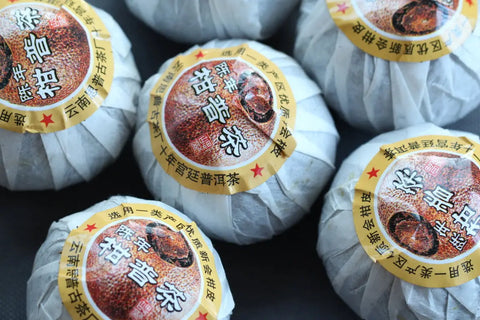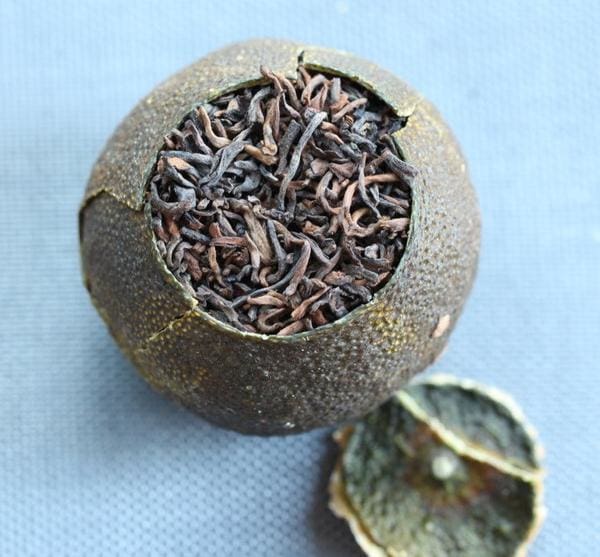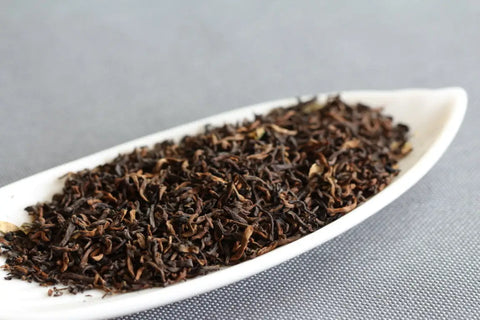
What is Orange Shu Puerh (Gan Puer Tea) and Why Should You Be Drinking It?
It has unfortunately become commonplace to associate shou or ripe pu’erh with earthier flavors and smells, ranging from musty basement to forest floor. Part of the problem lies at the feet of tea producers who attempt to sell stale or ruined batches of pu’erh as shou, which is disappointing.

The good news though is that there are very good shou pu’erhs that lack these earthy notes, and one in particular has been skyrocketing in popularity in mainland China: Xiao Qing Gan Pu. Not only does “Gan Pu” (the shortened nickname) taste amazing for a shou pu’erh, it tastes amazing in general, making it a perfect tea for nearly anyone—tea novices, pu’erh newcomers, connoisseurs, and special friends.
As one comes to expect from pu’erhs, Gan Pu is indeed aged, but what makes it unique relative to other kinds of tea is that it is stored in a dried green tangerine shell. And it is precisely the storage of this tea in such a special kind of fruit that imparts to it such wonderful flavor.
In the west, there are some who confuse the green color of oranges with the quality of being immature or raw, believing them to be unworthy in some respect or another. There’s a good reason for this mistaken intuition. When bananas are picked too soon, for example, they can appear green as well, and so we tend to set them out and let the oxidation processes take place, observing the transition to yellow and eventually brown.

This is not the case with oranges though. The green color of the orange is related to chlorophyll content, an important phytonutrient, and oranges lose this color in colder climates when the temperature drops. In more tropical climates, however, the warmer temperature remains stable, and so these citrus fruits will retain their green colors.
This is the case with the Xinhui tangerine, a special kind of green-shelled mandarin with exceptional flavor. This is also the reason why the name of this tea translates into the cute phrase: Little Green Tangerine Pu’erh.
While stored in the green shell of a Xinhui tangerine, the pu’erh begins to absorb its unique flavors and essential oils. In many ways, it is almost best to consider this a flavored tea, but it is important to realize that this flavoring is completely natural. There are no additives, no preservatives, no artificial ingredients of any kind. The citrus flavor of the tea comes entirely from resting inside the mandarin peel.
In addition to being a flavored tea and widely accessible to tea drinkers of all stripes (including those who have struggled to enjoy pu’erh), this pu’erh places itself firmly within the tradition of traditional Chinese medicine as well.
The Xinhui mandarin peel has long been prized for its medicinal qualities, believed to help sooth the lungs and throat while reducing excessive body heat. In the west, for example, we have similar thoughts about vitamin c, recommending it to those who come down with a cold or sinus infection. The idea within traditional Chinese medicine is similar, except the preference is given for whole foods, herbs, and oils over isolated chemicals.

For those who would like to partake in this tradition (or simply those looking for some additional flavor in their teas), it is strongly encouraged when preparing Gan Pu to break away some of the small bits and pieces of the mandarin shell to infuse along with the tea. It gives a slight boost to the citrus flavor—but rest assured that this is not just a cup of citrus. You can still taste the dark chocolate and caramel flavors of the shou pu’erh. The addition of the mandarin just gives it a citrusy undertone, somewhat like a piece of chocolate infused with orange peel essential oil.
Due to the popularity of Gan Pu, there have been more stuffed teas of varying levels of quality emerging in the market. Sometimes this practice is even used to mask the inferiority of stale or low-quality teas. Our Gan Pu, however, is authentic. The shell is indeed sourced from Xinhui in Guangdong Province and the ripened pu’erh comes from Menghai County in Yunnan Province.
What is more, this Gan Pu has been crafted with gong ting or “imperial palace” pu’erh (宫廷), a phrase used to denote the highest grade of leaf quality. It is important for us to not only introduce these novelty teas to the market, but to introduce those of high-quality so that our customers can appreciate and understand exactly why they’re so beloved.
The infusion of gong ting teas tends to be very smooth, almost silky, and they lack any trace of bitterness. By using gong ting pu’erh in this Gan Pu, we find that it creates a delightful sensory experience. The silky texture of the tea is very soothing, and the chocolatey and citrusy aromatics prove to be a match made in heaven. This is an extraordinarily well-rounded tea, almost dessert-like, and it is sure to please!
